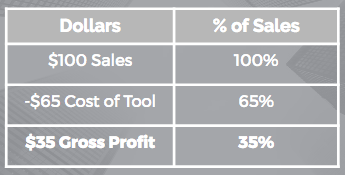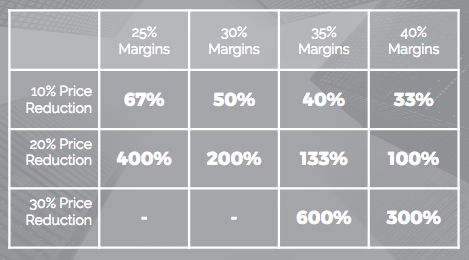"We are NOT in business to work harder. We are in business to make a profit."
“I’m planning on running a promotion this weekend.” It was a former client of mine who owned a retail store in a university town.
“What sort of promotion?” I asked.
“I don’t know. I've been thinking maybe a 25% percent discount on everything in the store. There’s a game this weekend and I want to pack ‘em in.”
“Are you open to discussion?" I asked.
“Sure, what do you have in mind?”
Discounting is a sign that we have not distinguished ourselves from our competitors.
Having no competitive advantage to exploit, we have to do something to attract business, and, as with my former client, most of us default to a discount pricing strategy.
The problem is that discounts, with only rare exceptions*, can quickly lead to disaster.

“Disaster?” you ask. “Everybody does it. What’s so disastrous about picking up more business?”
That's a great question.
To answer it, we have to revisit the purpose of business.
We are NOT in business to work harder. We are in business to make a profit. If working harder makes us more money, maybe we can live with that. If not, forget about it.
To know if discounts serve our purpose or not, we start with the question: ”How much more do we have to sell to pay for the cost of discounts?”
Download the Discount Calculator Now
That is a seldom asked, but very important question. The answer can change our lives.
How can we know? By using gross profit to figure out just how much business we would have to “pick up” in order to compensate for discounts.
Gross profit is the amount left over after subtracting cost of goods sold from sales.
For example: Say we own a tool shop and pay $65 for a tool we sell for $100. We have a $35 gross profit on each tool, which is another way of saying we have a gross profit margin of “35% of sales.”

Now let’s find the effect of a 20% discount. How much more would we have to sell just to recover the price reduction?
We might guess a 20% increase in sales would do it, but let’s see.
Take a look at the table below. The percentages across the top row are gross profit margins. The percentages down the left hand column are the discounts.
Look at the intersection of the 35% column and the 20% row. The number there is 133%, and that is the amount our sales would have to increase just to recover the cost of the 20% discount.

Yikes!
Read that again: our sales would have to go up 133% - double plus another third – just to keep the gross profit we had before the discount.
That is a high bar to hurdle. Even if we did it, we would find ourselves working twice as hard for the same gross profit.
Now that would be a disaster!
Such a dramatic effect might seem counter-intuitive, but it makes perfect sense. Think of gross profit margin as our share of a sales dollar, because it is.
"Just because we chose to discount, didn’t mean our suppliers reduced their bills."
In the example, our share is $.35 and the remaining $.65 goes to pay the tool supplier. The dramatic effect is due to the fact that the $.20 discounts come entirely from our $.35 share.
After all, just because we chose to discount, didn’t mean our suppliers reduced their bills.
Understanding discounts gives us the incentive to find alternatives.
Take my former client for example. Instead of the 25% discount, he chose to give away a free promotional item with every purchase. I’ll save you the math, but his weekend sales were up 30% to $6,000, his gross profit minus the cost of the gift was $1,560.
Had he run the 25% discount, equivalent transactions would have generated $4,500 of sales with gross profit of $600.
My client’s free gift offer outperformed a simple 25% discount, but the ultimate answer to discounts and price competition is to create and claim a competitive advantage, other than price, for your businesses.
My article “Why Should I Buy from You” and my download USP Workbook will start you toward the day you say with confidence “No way, will I discount again.”
To make calculations easy, download my discount calculator. By entering three numbers, it will show how much more you have to sell at any combination of margins and discount.
Discounting is a legitimate tool for reducing obsolete inventory (in other words, for correcting previous inventory mistakes).
Discounting can be an effective strategy to “buy” customers so long as the lifetime value of the customer is significantly greater than the cost of discount.
In either case, it is always worthwhile to understand the effects of discounting and to explore alternatives before resorting to price concessions.
Are you getting busier but making less? Do you discount? Do you know how much more you have to sell to pay for them?
As always, thank you for reading this article. I am committed to providing clear, practical and useful information that business owners can use to make decisions and improve their lives. I value your comments and welcome your suggestions for future articles. Please leave your comments and suggestions in the comment box below.